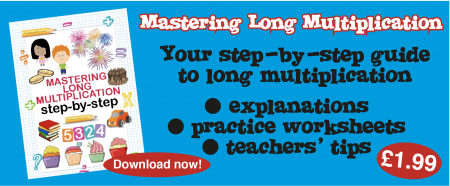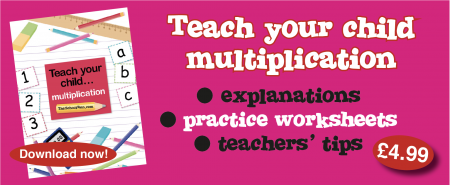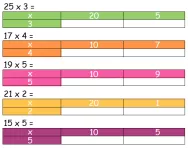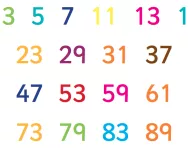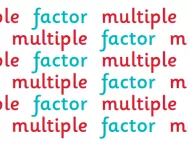Important update from TheSchoolRun
For the past 13 years, TheSchoolRun has been run by a small team of mums working from home, dedicated to providing quality educational resources to primary school parents. Unfortunately, rising supplier costs and falling revenue have made it impossible for us to continue operating, and we’ve had to make the difficult decision to close. The good news: We’ve arranged for another educational provider to take over many of our resources. These will be hosted on a new portal, where the content will be updated and expanded to support your child’s learning.
What this means for subscribers:
- Your subscription is still active, and for now, you can keep using the website as normal — just log in with your usual details to access all our articles and resources*.
- In a few months, all resources will move to the new portal. You’ll continue to have access there until your subscription ends. We’ll send you full details nearer the time.
- As a thank you for your support, we’ll also be sending you 16 primary school eBooks (worth £108.84) to download and keep.
A few changes to be aware of:
- The Learning Journey weekly email has ended, but your child’s plan will still be updated on your dashboard each Monday. Just log in to see the recommended worksheets.
- The 11+ weekly emails have now ended. We sent you all the remaining emails in the series at the end of March — please check your inbox (and spam folder) if you haven’t seen them. You can also follow the full programme here: 11+ Learning Journey.
If you have any questions, please contact us at [email protected]. Thank you for being part of our journey it’s been a privilege to support your family’s learning.
*If you need to reset your password, it will still work as usual. Please check your spam folder if the reset email doesn’t appear in your inbox.
What is long multiplication?
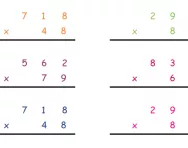
What is long multiplication?
Long multiplication (or column multiplication) is a written method of multiplying numbers (usually a two- or three-digit number by another large number).
It is usually used in Year 5 and Year 6 once children have got the hang of using the grid method. The benefit of the grid method is that it encourages children to think about place value and multiply multiples of ten and one hundred. Once they have got the hang of this, long multiplication is a faster, more efficient technique to use.
How to multiply using the long multiplication method
As in column addition and column subtraction, the numbers are positioned in a column as follows: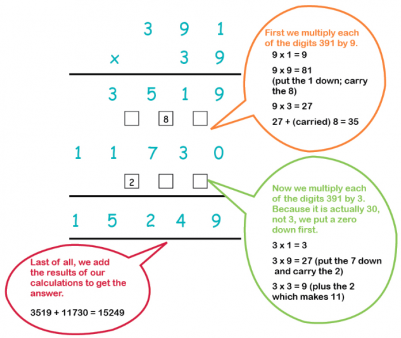
Multiplication in primary school
Children's multiplication skills are built up through their time at primary school as follows.
Year 1
- Count on or back in ones, twos, fives and tens.
- Solve one-step problems involving multiplication using objects and arrays with the support of the teacher.
Here is an example of an array to demonstrate 5 x 3 or 3 x 5:
Year 2
- Recall multiplication facts for the 2, 5 and 10 times tables and related division facts.
- Use repeated addition (representing 4 lots of 3 as 3 + 3 + 3 + 3) and arrays to work out multiplication questions.
- Recognise multiples of 2, 5 and 10.
- Use the x and = signs when writing multiplication number sentences.
- Solve problems involving multiplication using objects and arrays (see diagram above).
Year 3
- Recall multiplication facts for the 2, 3, 4, 5, 8 and 10 times tables and the corresponding division facts.
- Use written methods to multiply two-digit numbers by one-digit numbers (for example: 13 x 4).
Year 4
- Recall multiplication facts up to 12 x 12 and corresponding division facts.
- Recognise and use factor pairs.
- Multiply two-digit and three-digit numbers by a one-digit number using a formal written layout.
Year 5
- Identify multiples and factors.
- Recognise prime numbers have only two factors and identify prime numbers less than 100.
- Understand square and cubed numbers.
- Multiply numbers up to four digits by a one-digit or two-digit number using formal methods, including long multiplication.
As you can see from the above objectives, children do not need to multiply two-digit numbers by three-digit numbers until Year 6, so the long multiplication method would probably not be taught until then (although able Year 5 children may use it as well).
Year 6
- Multiply numbers up to four digits by a two-digit number using long multiplication.
- Identify common factors, common multiples and prime numbers.
- Multiply one-digit numbers with up to two decimal places by whole numbers.
